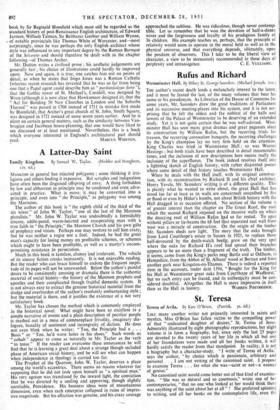Wren and the Rest
The Age of Wren. By Ralph Dutton. (Batsford. 42s.)
SINCE the bicentenary of Sir Christopher Wren's death came round in 1923, several biographies of the great architect have appeared, easily the best being Mr. Geoffrey Webb's of 1937. There have alsooappeared the twenty volumes of the Wren Society's publication ; these, which document not only the buildings of Wren himself but also many of those of his contemporaries, constitute one of the twa major reference works in the field of English architectural history so far completed. (The other is the twelve-volume Dictionary of Architecture brought out by the Architectural Publication Society in 1852-92.) What there has not-been hitherto, and what Mr. Ralph Dutton has now written, is a book that sets out to give a consecutive • account of the Wren period as a whole.
Mr. Dutton's story begins in the 1660s with Wren's first archi- tectural works, and ends with the late designs of the Baroque schooi in the 1730s, when the Palladianism of Lord Burlington's circle had already established itself as the " progressive " architecture of the day. He tells it in six chapters, the first an introductory one, the next three on Wren himself, the fifth on what he calls the lesser company" and the last on Vanbrugh, Hawksmoor and Gibbs. This bare enumeration of contents may suggest that Mr. Dutton finds
the architecture of the second half of his period less to his taste than that of the first—and in fact his last chapter is among the shorter of the six, with the result that Vanbrugh, Hawksmoor ani Gibbs between them get less than a third of the amount of space allotted to Wren ; yet on putting down the book one does not feel that those three architects have been hardly done by.
A chapter that should be particularly valuable to the non-specialist reader with no call to keep abreast of the occasional literature of architectural scholarship is the one on "the lesser company." Ia this Mr. Dutton discusses the buildings of Hugh May and Robert Ilooke, two men whose very names do- not occur in the 50-year-old book by Sir Reginald BlomfieId which must still be regarded as the standard history of post-Renaissance English architecture, of Edward Jarman, William Talman, Sir Balthazar Gerbier and William Wynne, of notable provincials like Thomas White of Worcester, and—most surprisingly, since he was perhaps the only English architect whose style was influenced to any important degree by the Roman Baroque of the Seicento and should therefore be dealt with in the chapter following—of Thomas Archer.
Mr. Dutton writes a civilised prose ; his aesthetic judgements are generally fair ; his choice of illustrations could hardly be improved upon. Now and again, it is true, one catches him out on points of detail, as when he states that Inigo Jones was a Roman Catholic (whereas recent research has revealed that he was so far from being one that a Papal agent could describe him as "puritanissitno fiero"), . that the Gothic tower of St. Michael's, Cornhill, was designed by Wren (although it is now clear that Hawksmoor designed it), that the "Act for Building 50 New Churches in London and the Suburbs -
Thereof" was passed in 1708 instead of 1711 (a mistake first made by Blomfield), that Archer's great church of St. John, Smith Square, was designed in 1721 instead of some seven years earlier. And he is silent on certain general matters, such as the similarity between Van- brugian and Jacobean house-planning, that one would have liked to see discussed or at least mentioned. Nevertheless, this is a book which everyone interested in England's architectural past should































 Previous page
Previous page